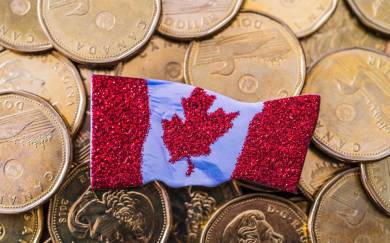Currency Speculators raise their bullish bets for Canadian Dollar to 40-week high

Invest Macro 23.04.2022 20:49
By InvestMacro | COT | Data Tables | COT Leaders | Downloads | COT Newsletter
Here are the latest charts and statistics for the Commitment of Traders (COT) data published by the Commodities Futures Trading Commission (CFTC).
The latest COT data is updated through Tuesday April 19th and shows a quick view of how large traders (for-profit speculators and commercial entities) were positioned in the futures markets. All currency positions are in direct relation to the US dollar where, for example, a bet for the euro is a bet that the euro will rise versus the dollar while a bet against the euro will be a bet that the euro will decline versus the dollar.
Highlighting the COT currency data is the rising of bullish bets in the Canadian ‘Loonie’ dollar currency futures contracts. CAD speculators raised their bullish bets for a fourth straight week this week and for the fifth time in the past six weeks. Over the past four-week time-frame, CAD bets have improved by a total of +26,166 contracts, going from -4,940 net positions on March 22nd to +21,226 net positions this week. These gains have brought this week’s speculator level to the most bullish position since July 13th of 2021, a span of forty weeks.
This recent improvement in Loonie sentiment has been helped out by the hike in interest rates by the Bank of Canada (BOC). The BOC recently pushed its key interest rate higher by 50 basis points on April 13th and has in the past few days hinted that more interest rate rises were to come. The recent inflation numbers out of Canada were above expectations (6.7 percent) and according to Bloomberg, market participants have pushed their odds to 100 percent for another 50 basis point hike in June.
Overall, the currencies with higher speculator bets this week were the US Dollar Index (2,943 contracts), Japanese yen (4,640 contracts), Swiss franc (2,492 contracts), New Zealand dollar (654 contracts), Canadian dollar (9,068 contracts)and the Mexican peso (6,704 contracts).
The currencies with declining bets were the Euro (-7,759 contracts), Brazil real (-1,557 contracts), Australian dollar (-122 contracts), Bitcoin (-361 contracts) and the British pound sterling (-5,860 contracts).
Speculator strength standings for each Commodity where strength index is current net position compared to past three years, above 80 is bullish extreme, below 20 is bearish extreme
Data Snapshot of Forex Market Traders | Columns Legend
Apr-19-2022
OI
OI-Index
Spec-Net
Spec-Index
Com-Net
COM-Index
Smalls-Net
Smalls-Index
USD Index
54,524
77
32,580
82
-35,893
15
3,313
53
EUR
675,939
72
31,301
45
-49,726
62
18,425
5
GBP
249,529
70
-58,914
32
72,889
73
-13,975
27
JPY
251,291
90
-107,187
3
129,842
99
-22,655
7
CHF
44,269
20
-11,450
50
23,051
57
-11,601
29
CAD
153,302
32
21,226
68
-39,338
31
18,112
66
AUD
147,309
43
-28,837
58
20,800
34
8,037
72
NZD
41,098
26
365
72
503
31
-868
42
MXN
165,403
33
21,664
37
-26,214
62
4,550
62
RUB
20,930
4
7,543
31
-7,150
69
-393
24
BRL
70,553
68
44,572
94
-47,063
5
2,491
94
Bitcoin
11,276
61
-194
90
-175
0
369
21
US Dollar Index Futures:
The US Dollar Index large speculator standing this week reached a net position of 32,580 contracts in the data reported through Tuesday. This was a weekly lift of 2,943 contracts from the previous week which had a total of 29,637 net contracts.
This week’s current strength score (the trader positioning range over the past three years, measured from 0 to 100) shows the speculators are currently Bullish-Extreme with a score of 82.0 percent. The commercials are Bearish-Extreme with a score of 15.0 percent and the small traders (not shown in chart) are Bullish with a score of 52.8 percent.
US DOLLAR INDEX Statistics
SPECULATORS
COMMERCIALS
SMALL TRADERS
– Percent of Open Interest Longs:
85.6
3.3
9.5
– Percent of Open Interest Shorts:
25.9
69.1
3.5
– Net Position:
32,580
-35,893
3,313
– Gross Longs:
46,685
1,778
5,198
– Gross Shorts:
14,105
37,671
1,885
– Long to Short Ratio:
3.3 to 1
0.0 to 1
2.8 to 1
NET POSITION TREND:
– Strength Index Score (3 Year Range Pct):
82.0
15.0
52.8
– Strength Index Reading (3 Year Range):
Bullish-Extreme
Bearish-Extreme
Bullish
NET POSITION MOVEMENT INDEX:
– 6-Week Change in Strength Index:
-2.5
3.3
-5.8
Euro Currency Futures:
The Euro Currency large speculator standing this week reached a net position of 31,301 contracts in the data reported through Tuesday. This was a weekly lowering of -7,759 contracts from the previous week which had a total of 39,060 net contracts.
This week’s current strength score (the trader positioning range over the past three years, measured from 0 to 100) shows the speculators are currently Bearish with a score of 44.6 percent. The commercials are Bullish with a score of 61.9 percent and the small traders (not shown in chart) are Bearish-Extreme with a score of 4.9 percent.
EURO Currency Statistics
SPECULATORS
COMMERCIALS
SMALL TRADERS
– Percent of Open Interest Longs:
32.7
53.7
11.4
– Percent of Open Interest Shorts:
28.1
61.0
8.7
– Net Position:
31,301
-49,726
18,425
– Gross Longs:
221,003
362,930
76,939
– Gross Shorts:
189,702
412,656
58,514
– Long to Short Ratio:
1.2 to 1
0.9 to 1
1.3 to 1
NET POSITION TREND:
– Strength Index Score (3 Year Range Pct):
44.6
61.9
4.9
– Strength Index Reading (3 Year Range):
Bearish
Bullish
Bearish-Extreme
NET POSITION MOVEMENT INDEX:
– 6-Week Change in Strength Index:
-8.5
9.7
-10.9
British Pound Sterling Futures:
The British Pound Sterling large speculator standing this week reached a net position of -58,914 contracts in the data reported through Tuesday. This was a weekly decrease of -5,860 contracts from the previous week which had a total of -53,054 net contracts.
This week’s current strength score (the trader positioning range over the past three years, measured from 0 to 100) shows the speculators are currently Bearish with a score of 31.6 percent. The commercials are Bullish with a score of 72.8 percent and the small traders (not shown in chart) are Bearish with a score of 26.7 percent.
BRITISH POUND Statistics
SPECULATORS
COMMERCIALS
SMALL TRADERS
– Percent of Open Interest Longs:
14.8
74.6
8.8
– Percent of Open Interest Shorts:
38.4
45.4
14.4
– Net Position:
-58,914
72,889
-13,975
– Gross Longs:
36,811
186,134
21,987
– Gross Shorts:
95,725
113,245
35,962
– Long to Short Ratio:
0.4 to 1
1.6 to 1
0.6 to 1
NET POSITION TREND:
– Strength Index Score (3 Year Range Pct):
31.6
72.8
26.7
– Strength Index Reading (3 Year Range):
Bearish
Bullish
Bearish
NET POSITION MOVEMENT INDEX:
– 6-Week Change in Strength Index:
-33.4
28.1
-2.2
Japanese Yen Futures:
The Japanese Yen large speculator standing this week reached a net position of -107,187 contracts in the data reported through Tuesday. This was a weekly lift of 4,640 contracts from the previous week which had a total of -111,827 net contracts.
This week’s current strength score (the trader positioning range over the past three years, measured from 0 to 100) shows the speculators are currently Bearish-Extreme with a score of 2.9 percent. The commercials are Bullish-Extreme with a score of 99.0 percent and the small traders (not shown in chart) are Bearish-Extreme with a score of 7.4 percent.
JAPANESE YEN Statistics
SPECULATORS
COMMERCIALS
SMALL TRADERS
– Percent of Open Interest Longs:
5.1
86.0
8.3
– Percent of Open Interest Shorts:
47.7
34.3
17.3
– Net Position:
-107,187
129,842
-22,655
– Gross Longs:
12,723
216,101
20,761
– Gross Shorts:
119,910
86,259
43,416
– Long to Short Ratio:
0.1 to 1
2.5 to 1
0.5 to 1
NET POSITION TREND:
– Strength Index Score (3 Year Range Pct):
2.9
99.0
7.4
– Strength Index Reading (3 Year Range):
Bearish-Extreme
Bullish-Extreme
Bearish-Extreme
NET POSITION MOVEMENT INDEX:
– 6-Week Change in Strength Index:
-31.6
25.9
-3.8
Swiss Franc Futures:
The Swiss Franc large speculator standing this week reached a net position of -11,450 contracts in the data reported through Tuesday. This was a weekly increase of 2,492 contracts from the previous week which had a total of -13,942 net contracts.
This week’s current strength score (the trader positioning range over the past three years, measured from 0 to 100) shows the speculators are currently Bearish with a score of 50.0 percent. The commercials are Bullish with a score of 56.8 percent and the small traders (not shown in chart) are Bearish with a score of 29.2 percent.
SWISS FRANC Statistics
SPECULATORS
COMMERCIALS
SMALL TRADERS
– Percent of Open Interest Longs:
6.6
71.7
21.7
– Percent of Open Interest Shorts:
32.4
19.6
47.9
– Net Position:
-11,450
23,051
-11,601
– Gross Longs:
2,900
31,735
9,599
– Gross Shorts:
14,350
8,684
21,200
– Long to Short Ratio:
0.2 to 1
3.7 to 1
0.5 to 1
NET POSITION TREND:
– Strength Index Score (3 Year Range Pct):
50.0
56.8
29.2
– Strength Index Reading (3 Year Range):
Bearish
Bullish
Bearish
NET POSITION MOVEMENT INDEX:
– 6-Week Change in Strength Index:
-3.0
1.3
1.8
Canadian Dollar Futures:
The Canadian Dollar large speculator standing this week reached a net position of 21,226 contracts in the data reported through Tuesday. This was a weekly advance of 9,068 contracts from the previous week which had a total of 12,158 net contracts.
This week’s current strength score (the trader positioning range over the past three years, measured from 0 to 100) shows the speculators are currently Bullish with a score of 67.7 percent. The commercials are Bearish with a score of 31.1 percent and the small traders (not shown in chart) are Bullish with a score of 65.8 percent.
CANADIAN DOLLAR Statistics
SPECULATORS
COMMERCIALS
SMALL TRADERS
– Percent of Open Interest Longs:
28.7
45.0
24.6
– Percent of Open Interest Shorts:
14.9
70.7
12.8
– Net Position:
21,226
-39,338
18,112
– Gross Longs:
44,063
68,989
37,784
– Gross Shorts:
22,837
108,327
19,672
– Long to Short Ratio:
1.9 to 1
0.6 to 1
1.9 to 1
NET POSITION TREND:
– Strength Index Score (3 Year Range Pct):
67.7
31.1
65.8
– Strength Index Reading (3 Year Range):
Bullish
Bearish
Bullish
NET POSITION MOVEMENT INDEX:
– 6-Week Change in Strength Index:
13.4
-17.2
20.4
Australian Dollar Futures:
The Australian Dollar large speculator standing this week reached a net position of -28,837 contracts in the data reported through Tuesday. This was a weekly decline of -122 contracts from the previous week which had a total of -28,715 net contracts.
This week’s current strength score (the trader positioning range over the past three years, measured from 0 to 100) shows the speculators are currently Bullish with a score of 58.1 percent. The commercials are Bearish with a score of 34.4 percent and the small traders (not shown in chart) are Bullish with a score of 72.0 percent.
AUSTRALIAN DOLLAR Statistics
SPECULATORS
COMMERCIALS
SMALL TRADERS
– Percent of Open Interest Longs:
26.6
53.8
19.2
– Percent of Open Interest Shorts:
46.2
39.6
13.7
– Net Position:
-28,837
20,800
8,037
– Gross Longs:
39,201
79,208
28,257
– Gross Shorts:
68,038
58,408
20,220
– Long to Short Ratio:
0.6 to 1
1.4 to 1
1.4 to 1
NET POSITION TREND:
– Strength Index Score (3 Year Range Pct):
58.1
34.4
72.0
– Strength Index Reading (3 Year Range):
Bullish
Bearish
Bullish
NET POSITION MOVEMENT INDEX:
– 6-Week Change in Strength Index:
45.8
-42.8
19.6
New Zealand Dollar Futures:
The New Zealand Dollar large speculator standing this week reached a net position of 365 contracts in the data reported through Tuesday. This was a weekly boost of 654 contracts from the previous week which had a total of -289 net contracts.
This week’s current strength score (the trader positioning range over the past three years, measured from 0 to 100) shows the speculators are currently Bullish with a score of 71.9 percent. The commercials are Bearish with a score of 31.2 percent and the small traders (not shown in chart) are Bearish with a score of 41.9 percent.
NEW ZEALAND DOLLAR Statistics
SPECULATORS
COMMERCIALS
SMALL TRADERS
– Percent of Open Interest Longs:
46.4
45.9
6.8
– Percent of Open Interest Shorts:
45.5
44.6
8.9
– Net Position:
365
503
-868
– Gross Longs:
19,081
18,853
2,797
– Gross Shorts:
18,716
18,350
3,665
– Long to Short Ratio:
1.0 to 1
1.0 to 1
0.8 to 1
NET POSITION TREND:
– Strength Index Score (3 Year Range Pct):
71.9
31.2
41.9
– Strength Index Reading (3 Year Range):
Bullish
Bearish
Bearish
NET POSITION MOVEMENT INDEX:
– 6-Week Change in Strength Index:
21.4
-20.2
4.0
Mexican Peso Futures:
The Mexican Peso large speculator standing this week reached a net position of 21,664 contracts in the data reported through Tuesday. This was a weekly advance of 6,704 contracts from the previous week which had a total of 14,960 net contracts.
This week’s current strength score (the trader positioning range over the past three years, measured from 0 to 100) shows the speculators are currently Bearish with a score of 36.6 percent. The commercials are Bullish with a score of 61.9 percent and the small traders (not shown in chart) are Bullish with a score of 62.3 percent.
MEXICAN PESO Statistics
SPECULATORS
COMMERCIALS
SMALL TRADERS
– Percent of Open Interest Longs:
44.6
50.0
4.7
– Percent of Open Interest Shorts:
31.5
65.8
1.9
– Net Position:
21,664
-26,214
4,550
– Gross Longs:
73,710
82,643
7,701
– Gross Shorts:
52,046
108,857
3,151
– Long to Short Ratio:
1.4 to 1
0.8 to 1
2.4 to 1
NET POSITION TREND:
– Strength Index Score (3 Year Range Pct):
36.6
61.9
62.3
– Strength Index Reading (3 Year Range):
Bearish
Bullish
Bullish
NET POSITION MOVEMENT INDEX:
– 6-Week Change in Strength Index:
-13.4
12.1
10.1
Brazilian Real Futures:
The Brazilian Real large speculator standing this week reached a net position of 44,572 contracts in the data reported through Tuesday. This was a weekly fall of -1,557 contracts from the previous week which had a total of 46,129 net contracts.
This week’s current strength score (the trader positioning range over the past three years, measured from 0 to 100) shows the speculators are currently Bullish-Extreme with a score of 94.2 percent. The commercials are Bearish-Extreme with a score of 5.4 percent and the small traders (not shown in chart) are Bullish-Extreme with a score of 94.0 percent.
BRAZIL REAL Statistics
SPECULATORS
COMMERCIALS
SMALL TRADERS
– Percent of Open Interest Longs:
76.2
17.6
6.1
– Percent of Open Interest Shorts:
13.1
84.3
2.5
– Net Position:
44,572
-47,063
2,491
– Gross Longs:
53,790
12,399
4,272
– Gross Shorts:
9,218
59,462
1,781
– Long to Short Ratio:
5.8 to 1
0.2 to 1
2.4 to 1
NET POSITION TREND:
– Strength Index Score (3 Year Range Pct):
94.2
5.4
94.0
– Strength Index Reading (3 Year Range):
Bullish-Extreme
Bearish-Extreme
Bullish-Extreme
NET POSITION MOVEMENT INDEX:
– 6-Week Change in Strength Index:
-5.8
5.4
5.0
Bitcoin Futures:
The Bitcoin large speculator standing this week reached a net position of -194 contracts in the data reported through Tuesday. This was a weekly decline of -361 contracts from the previous week which had a total of 167 net contracts.
This week’s current strength score (the trader positioning range over the past three years, measured from 0 to 100) shows the speculators are currently Bullish-Extreme with a score of 90.2 percent. The commercials are Bearish with a score of 27.4 percent and the small traders (not shown in chart) are Bearish with a score of 21.3 percent.
BITCOIN Statistics
SPECULATORS
COMMERCIALS
SMALL TRADERS
– Percent of Open Interest Longs:
73.3
3.6
10.2
– Percent of Open Interest Shorts:
75.0
5.2
7.0
– Net Position:
-194
-175
369
– Gross Longs:
8,263
408
1,155
– Gross Shorts:
8,457
583
786
– Long to Short Ratio:
1.0 to 1
0.7 to 1
1.5 to 1
NET POSITION TREND:
– Strength Index Score (3 Year Range Pct):
90.2
27.4
21.3
– Strength Index Reading (3 Year Range):
Bullish-Extreme
Bearish
Bearish
NET POSITION MOVEMENT INDEX:
– 6-Week Change in Strength Index:
-9.8
19.8
4.8
Article By InvestMacro – Receive our weekly COT Reports by Email
*COT Report: The COT data, released weekly to the public each Friday, is updated through the most recent Tuesday (data is 3 days old) and shows a quick view of how large speculators or non-commercials (for-profit traders) were positioned in the futures markets.
The CFTC categorizes trader positions according to commercial hedgers (traders who use futures contracts for hedging as part of the business), non-commercials (large traders who speculate to realize trading profits) and nonreportable traders (usually small traders/speculators) as well as their open interest (contracts open in the market at time of reporting).See CFTC criteria here.


 Mikołaj Marcinowski 30.03.2022 16:05
Mikołaj Marcinowski 30.03.2022 16:05





 ING Economics 03.09.2022 09:12
ING Economics 03.09.2022 09:12

 Kamila Szypuła 18.10.2022 10:21
Kamila Szypuła 18.10.2022 10:21







 Matt Weller CFA 16.06.2023 08:50
Matt Weller CFA 16.06.2023 08:50

 Kenny Fisher 22.06.2023 08:26
Kenny Fisher 22.06.2023 08:26

 Ipek Ozkardeskaya 26.06.2023 08:06
Ipek Ozkardeskaya 26.06.2023 08:06



 Ed Moya 04.07.2023 08:08
Ed Moya 04.07.2023 08:08












 Craig Erlam 04.09.2023 10:58
Craig Erlam 04.09.2023 10:58









